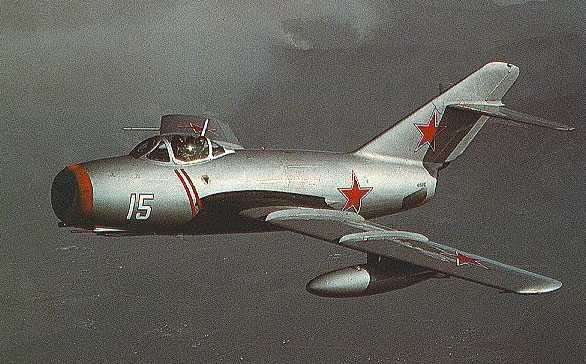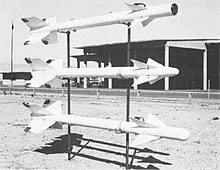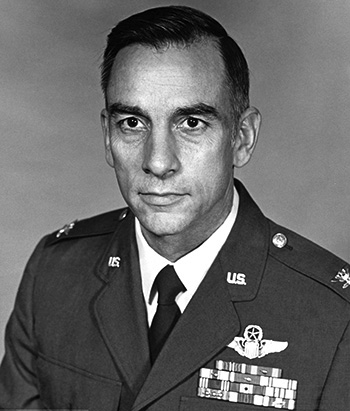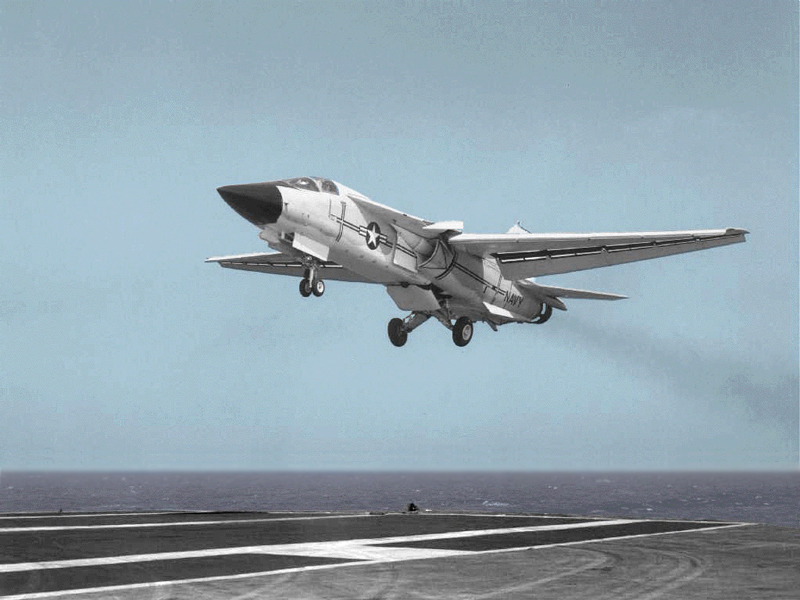 |
| The F-86 was America's air superiority fighter over Korea |
MiG Ambush at Thanh Hoa Bridge
Based on content from Wikipedia, the free encyclopedia
 |
| Russia supplied North Korea with its best Mig -15 jets and pilots |
Americans are familiar with the lore of how Viet Cong guerillas in pajamas defeated the might American army (actually it didn't quite happen that way). A less familiar story is the pivotal air battle above the Thanh Hoa "Dragons' Jaw" bridge in 1965 in which America's first shocking defeat in the air war over Vietnam changed supersonic jet combat forever. The North American P-51 eventually won the skies over Germany. At the end of 1950, Americans were shocked by the appearance of the Soviet swept-wing Mig-15, often with seasoned Russian pilots. It was their most advanced fighter which was 100 mph faster than the F-80 Shooting Star and flew rings around every straight-winged jet they had. Only by hurriedly shipping in their own most-advanced swept-wing F-86 Sabre (essentially a rework of the FJ-1 Fury which was a jet-engined P-51Mustang) did the USAF eventually rack up a claimed 10:1 kill ratio.
 |
| F-100 Super Sabre |
Since then, America had developed two generations of "Century Series" of supersonic fighters. The F-100 Super Sabre was an F-86 beefed up to speeds making it America's first Mach 1+ supersonic daylight fighter-bomber. It was armed with cannon and Sidewinder missles, comparable to the MiG-19 with a big wing for dogfighting.
The F-105 was a sleek giant brute, America's largest single engine fighter which was as fast as the MiG-21 any modern Mach 2 fighter. It was optimized to swoop in at low level in any weather at low level to deliver an internal nuclear weapon, but could also lug up to 15,000 lbs of bombs or typical 4,000 lb load at long range like the WWII B-17 bomber. For that mission, it had tiny stub wings that made it a bear to turn, but it could be a secondary dogfighter for self defence as it retained the potent M-61 Gatling Gun 20mm cannon, and could carry a pair Sidewinder missles if it wasn't tasked as a bomber. Bombed up, it was sitting duck, but in the early days, the "Thud" as it was affectionately known for the sound one made if it fell from the sky accounted for most MiG kills, and even ended the war with a slightly better than 1:1 kill ratio. It would deliver the bulk of USAF bombs until the loss of half of the flee. The F-105's purpose-built replacement was the troubled swing-wing F-111, which was a dismal failure as the all-roles for all services fighter, but ultimately did serve in last days of the air war as a specialized Air Force bomber. The Thud would first be escorted and then replaced by the even more legendary F-4 Phantom which wasn't any faster but ultimately proved to actually be the all-role all service fighter sought by Secretary of Defence McNamara.
 |
| The U.S. Navy's Sidewinder in the early 1970s |
After Korea, jet fighter design moved on to supersonic, then double-sonic speeds. As fighter armament evolved from 50 cal machine guns to 20 mm cannon to rockets, the ultimate development was the Navy's AIM-9 infrared guided Sidewinder short-range and AIM-9 Sparrow medium range radar guided missles, as well as the AIM-4 Falcon favored by Air Force interceptors. Fighters were specialized either as gun-armed daylight fighters like the F-8 Crusader and F-100 Super Sabre, while all-weather interceptors carried larger radar and missles, sometimes in internal bay to shoot down bombers at long range. The Navy's F-4 Phantom was originally proposed with cannon, but was ultimately produced as an interceptor without guns, as was the Air Force F-102 and F-106 interceptors for continental defence.
America's first major air attack against a strategic target was a massive armada of F-105 "Thuds" to deliver bombs and advanced guided Bullpup missles and F-100 "Hun" supersonic jets to dogfight with any MiGs that might show up. Americans intelligence knew they would be opposed by a very small band of inexperienced pilots flying obsolete subsonic MiG-17s, which had been introduced as slightly improved MiG-15s towards the end of the Korean war. While the Soviets provided their very most modern jets and pilots in Korea, by Vietnam it was the best the Russians could spare their ally as faster MiG-19s and MiG-21s would not be available until later years.
Yet aided by ground controllers, the communist pilots were able to bypass the escorts and ambush the F-105s, downing 3 Thuds. They claimed a major victory though they lost 3 of their 4 defending planes in the subsequent dogfight. The most important outcome is that Americans would be forced to rethink tactics, training and even fighter design as the Navy shot down its sophisticated F-111B which could down six bombers at a time 100 miles away, yet lacked even short-range guns or sidewinder missiles to shoot at, much less the performance to dogfight an elderly MiG-17.
It was only after the wars end that the Navy was the first to roll out its purpose-built F-14 Tomcat air-superiority and fleet defence fighter. Unlike the F-111B had to satisfy every imaginable requirement EXCEPT dogfighting, plus Air Force bomber requirements (the Air Force F-111s were eventually was fitted with sidewinders for self-defence), the Tomcat was specifically designed for agility. While the F-4 Phantom was once heralded for doing away with the obsolete canon, and was roundly criticized for lacking a canon over Vietnam, the F-14 and every other fighter afterwards was designed with an internal cannon, along with sidewinder dogfight and sparrow missles, with the same massive bombload as the Phantom, which was used as the "bombcat" late in its career. The Air Force's stopgap answer to the humiliating performance over the Dragon's Jaw was the F-4E Phantom which had maneuver slats and added a M61 Vulcan cannon in its nose, and then the legendary F-15 Eagle which eschewed swing wings and the heavy AWG-9/AIM-54 Phoenix.
It was only after the wars end that the Navy was the first to roll out its purpose-built F-14 Tomcat air-superiority and fleet defence fighter. Unlike the F-111B had to satisfy every imaginable requirement EXCEPT dogfighting, plus Air Force bomber requirements (the Air Force F-111s were eventually was fitted with sidewinders for self-defence), the Tomcat was specifically designed for agility. While the F-4 Phantom was once heralded for doing away with the obsolete canon, and was roundly criticized for lacking a canon over Vietnam, the F-14 and every other fighter afterwards was designed with an internal cannon, along with sidewinder dogfight and sparrow missles, with the same massive bombload as the Phantom, which was used as the "bombcat" late in its career. The Air Force's stopgap answer to the humiliating performance over the Dragon's Jaw was the F-4E Phantom which had maneuver slats and added a M61 Vulcan cannon in its nose, and then the legendary F-15 Eagle which eschewed swing wings and the heavy AWG-9/AIM-54 Phoenix.
Contents
|
| Thanh Hoa bridge | |||||||
|---|---|---|---|---|---|---|---|
| Part of the Vietnam War | |||||||
 Thanh Hoa Bridge after it was hit by laser-guided bombs | |||||||
| |||||||
| Belligerents | |||||||
| Casualties and losses | |||||||
| 11 aircraft destroyed | 3 MiG-17 (1965) [1 | ||||||
[edit]The bridge
Originally built by the French during the colonial era in Vietnam, the Thanh
Hoa bridge was sabotaged by the Viet Minh in 1945. From 1957, the
Vietnamese started rebuilding it.
It was a grey metallic construction, resting
on a central concrete pier, and on concrete abutments at each extremity.
Completed in 1964, and inaugurated by Ho Chi Minh himself, the final bridge was
540 feet (160 m) long, 56 feet (17 m) wide, and about 50 feet
(15 m) above the river.
Allowing the passage of both road and rail
traffic, it was a vital link between different regions of North Vietnam, and
when the war started, became a strategic passage for supplies and reinforcements
sent to the Viet Cong fighting in South Vietnam.
[edit]Operation Rolling Thunder
With the beginning of Operation Rolling
Thunder (the bombing campaign against strategic targets in
North Vietnam), the decision was made in March 1965 to interdict the North
Vietnamese rail system, including the Thanh Hóa bridge. The Vietnamese,
realizing the importance of the bridge, had set up an impressive air defense
network, five air defense regiments being stationed in the area.

F-105Ds en route to North
Vietnam.
[edit]First raid, first dogfight
The first — and largest — strike package to
be sent against the bridge was codenamed 9-Alpha. Led by Korean war ace
Colonel Robinson Risner,
it comprised 79 aircraft, including 46 F-105 Thunderchiefs as the main strike
force. Other types were 21 F-100 Super Sabres as AAA suppressors
to attack ground-based guns, 14 F-100s acting as MiG CAP (combat air patrol)
and two RF-101C Voodoos to do damage assessment, plus 10 KC-135 tanker aircraft. The F-100s were based in South
Vietnam, while the others were based acrossThailand. Flights of four F-105s from Koran
and Takhli would be air refueled over the Mekong River, then cross Laos to
just south of the bridge. The bombers would continue east until over the Gulf of Tonkin.
Launched on April 3, 1965, the attack saw all
strike aircraft deliver their payload.[2] Sixteen of the F-105s carried a
pair of Bullpup missiles,
one under each outer wing pylon. This was an early combat use of early
"smart" precision guided missiles that were guided by radio and
joystick, requiring two passes to launch each of two missiles per plane before
the evolution of laser-guided bombs which eventually felled the bridge late in
the war. Capt. Bill Meyerholt observed as the missile streaked toward the
bridge and made a good hit; when smoke cleared,there was no visible damage to
the bridge. The tiny 250 lb warheads merely charred the massive structure.
Crews grimly joked that Bullpups on the Dragon's Jaw were as effective as
shooting BB pellets at a Sherman tank[citation needed].
The other F-105s each carried 3 tons of
explosives in the form of eight 750 lb (340 kg) bombs, more
than B-17s had
delivered over targets like Berlin. The first wave of bombs drifted due to a
strong southwest wind. The last flight, led by Cpt. Carlyle S.
"Smitty" Harris, scored hits on the roadway and superstructure. After
32 Bullpups and 1200 bombs had decorated the bridge with numerous hits,
charring every part, the bridge did not fall, though traffic was stopped for a
few hours. This was the only result of the raid, which had cost two aircraft —
one F-100 (Lt. George C. Smith flying flak suppression) and one RF-101 — shot
down.
Risner's Thunderchief was crippled by ground
fire, but despite smoke in the cockpit, Risner continued to direct the strike
before flying safely back to Da Nang.
To meet the raid, the VPAF had sent out two
flights of four MiG-17PFs from Noi Bai
airbase at 9:47. The original plan was for the first flight to act as decoy.
The second flight never reached the strike force, as flight leader Pham Ngoc Lan spotted F-8E Crusaders from the USS Hancock covering
the operation. The metal-finished MiG-17PF which would later be finished in a
"snake" camouflage was an all-weather interceptor version of the MiG-17
first flown in 1951. Armed and 3 23mm cannons but no missles, it was a faster
upgraded MiG-15 fitted with an afterburning engine, and a radar-ranging
gunsight reversed-engineered from
the F-86A [3] . [4] By comparison, the American
Crusader was a daylight gunfighter capable of speeds of nearly twice the speed
of sound, armed with both cannon and Sidewinder missiles. Lan dived to attack
at about 1,000 feet, and fired at a range of 700 feet. His gun camera showed a
blazing F-8 which he reported had crashed. At 10:15 wingman Lieutenant Phan Van
Tuc fired on another F-8, claiming a second victory. Pilots Ho Van Quy and Tran
Minh Phuong also opened fire on two F-8s, but were out of gun range. In the
VPAF's evaluation, their success was due to proper preparation, using surprise
and engaging only in close dogfights. While the US Navy records that all of the
Crusaders returned, a plane flown by Lt. Cdr. Spence Thomas was so damaged it
diverted to Da Nang and was written off as destroyed upon landing. That could
make Lan's attack the first air-to-air kill not only by the VPAF's MiG-17s, but
the first air victory of the conflict.[2]The Navy recorded that an A-4 Skyhawk of Lt. Cdr. R. A. Vohden was
lost to AAA; Vohden spent the rest of the war as a POW. After his victory, Lan
found himself short on fuel. He elected to save his plane by making a hard
landing by a riverbed in the Ke Tam valley (Nghe An province). He ironically
was beseiged by locals who expected to find an American pilot until he showed
his VPAF badge.
The VPAF had nevertheless demonstrated the
ability to engage modern US fighters, and afterwards recognized April 3 as Air
Force's Day. On the American side, the failure to drop any spans led to a new
attack scheduled for the next day; it was expected by VPAF commanders. This
time, 80 planes were engaged, including 48 F-105s, carrying only 750 lb
(340 kg) bombs, as the inadequacy of the Bullpup had been fully
demonstrated.

A North Vietnamese MiG-17 in 1972 from an American gun camera.
[edit]MiG-17s jump USAF F-105s
During the 4 April 1965 engagement, a tiny
force of eight MiG-17s (half flying as decoys) from the 921st "Sao
Do" (Red Star) Fighter Regiment (FR) was again given the daunting task of
confronting a massive armada of modern American supersonic fighter-bombers.[5]The 46 F-105 Thunderchiefs tasked as
fast attack bombers were escorted by a flight of 21 F-100 Super Sabres daylight
fighters from the 416th Tactical Fighter Squadron (TFS), 4Sidewinder-armed for MiGCAP,
and 17 armed with 2.75-inch HVAR to suppress AAA batteries. Each flight was
given a call sign. These included "Steel," "Iron,"
"Copper," "Moon," "Carbon," "Zinc,"
"Argon," "Graphite," "Esso," "Mobil,"
"Shell," and "Petrol." "Cadillac" flight
conducted Bomb Damage Assessment, while the search and rescue included A-1 Skyraiders, call sign "Sandy,"
and HH-3 Jolly Green
Giant rescue helicopters, call sign "Jolly Green."
The VPAF made ground-based AAA sites the
first line of defence, with fighters attacking after ground gunners ceased
fire. After taking off at about 10:20, the MiGs would break into decoy and
attack flights. The leader was second-in-command Nguyen Van Tien, while Dao Ngo
Ngu handled the ground control command.
Lieutenant General Trần Hanh in 1998
 |
| Tranh Hanh in wartime (dantri.com) |
Coming from clouds above, the MiG-17s tore
past the escorts and dove onto the bomb laden Thunderchiefs, Communist flight
leaderTrần Hanh spotted four F-105Ds at 10:30
starting to drop their bombs, ordering his wingman, Pham Giay, to cover his
attack. [6] He fired at 400 meters,
observing one F-105, piloted by Major Frank E. Bennett (355th TFW, KIA) fall in
flames into the Gulf of Tonkin. The flight leader attempted to recover at Da
Nang but had his controls freeze up within sight of the base. Ejecting, he was
killed when his parachute failed to open before he struck the water and he
drowned.[7] As the Thuds turned to attack
the MiGs, the MiG split into two groups on the north and south sides of the
bridge. Supported by Tran Nguyen Nam, Le Minh Huan downed another F-105D,
callsign Zinc 2 piloted by Capt. J. A. Magnusson. He radioed
that he was heading for the Gulf if he could maintain control of his aircraft.
Magnusson's aircraft finally bailed out 20 miles away over the Gulf of Tonkin
near the island of Hon Me, and was eventually listed as missing and then killed
after a 48-hour search.[8] The USAF confirmed the two
F-105 losses during that engagement.
The remaining fourth plane found himself in
the sights of another MiG-17 who he could not shake. In desperation, he tried a
snap roll which slowed his plane so that the MiG-17 over-shot him, as his
captain had recommended. Finding himself on the MiG's tail, he was too
surprised to attempt to shoot down the MiG with his gun. The fortunate survivor
was briefed the day before about this maneuver by the captain from Nellis whoes
name was the legendary John Boyd who
would be a significant voice in the design of America's future dogfighters.[9]
 |
| 416th TFS F-100Ds at Da Nang, 1965. |
After the quick success of downing two
American fighters, the outnumbered North Vietnamese defenders faced a sky full
of the remaining angered Thuds and Huns now fully alerted to their presence and
turning their attention to the MiGs. Tranh Hanh ordered his flight to split
into two groups. He and wingman Pham Giay stayed south side of the bridge,
while Le Minh Huan and Tran Nguyen Nam flew to the north. Three F-100s from the
MiGCAP, piloted by LTC Emmett L. Hays, CPT Keith B. Connolly,[10] and CPT Donald W. Kilgus, all
from the 416th TFS,[11] engaged the MiG-17s. As the
F-100s closed in, they hesitated to fire missiles which might hit their F-105s.
The lead F-100 got a locking tone as he fired an IR guided Sidewinder
air-to-air missile once he had a clear shot, but it passed above its target,
while Connolly and Kilgus engaged with 20mm cannon.
Kilgus recognized what was Pham Giay's MiG
just after it appeared out of the haze.[12] He dropped his wing tanks and
turned into the target that had just turned a 90 degree corner to face him. He
shook off Tranh Hanh's second MiG which appeared as Giay overshot and missed
him. Closing in from behind Giay, Kilgus closed in and pulled up his nose so that
the four M39 20mm guns
mounted under the belly of his airplane would just be visible winking to his
target. Lighting his afterburner and
using his height advantage, he accelerated and dived after the MiG at 450
knots. Kilgus recognized the Vietnamese pilot was pulling him into a game of chicken as both jets hurtled down
towards waters of the Gulf of Tonkin and the lighter MiG should have been able
pull out of a dangerous dive more quickly. Now headed nearly straight down, Kilgus
armed his guns and took aim at the spot projected on the glass of his A4
radar-ranging gunsight. [13] While worrying about the
rapidly falling altitude, he opened fire at 7,100 feet, observing puffs and
sparks coming off Giay's vertical tail fin before losing visual contact as he
pulled up, just barely clearing the Gulf of Tonkin.
Historian Don McCarthy later concluded he was
certain Kilgus brought down the MiG-17. Aviation writer Larry Davis also
records his that Kilgus' wing man also reported a kill, but it was denied by
higher headquarters at 7th Air Force. Although not immediately reported that
day, only Kilgus claimed and was credited with a probable kill. Based upon the
report, the F-100s had obtained the first US aerial combat victories during the
Vietnam War. If confirmed, Kilgus would have made the be the only air-to-air
MiG kill by an F-100 during the conflict.[14] , while it was assumed the
other MiGs escaped.
MiG-17 flight leader and sole survivor Tran
Hanh was credited with his confirmed F-105. His own plane narrowly escaped
through hard manoeuvring, but he lost contact with ground control. Low on fuel,
he opted to land at the nearby Ke Tam valley, but was detained the locals until
he produced his VPAF badge. Hanh says that he saw his wingman, Le Minh Huan and
Tran Nguyen Nam also shot down by F-105s.[15]. Hanh probably confused the
escorting F-100s for F-105s. As only one American pilot even claimed a probable
kill, his other comrades may have instead collided or been hit by their own AA
fire.[16] Nevertheless, in exchange for
their significant sacrifice, the North Vietnamese MiG-17s had scored their
first confirmed aerial victories in jet-to-jet combat against supersonic
fighters.


 |
| Col Carlyle Smitty Harris |

In North Vietnam, MiG-17 flight leader Tran
Hanh became a national hero. What in retrospect might seem to be tactical draw
after losing all of their defending fighters and three pilots, and viewed by
anti-war activists as aggression against civilian targets, the action was
celebrated as a "glorious victory over US aircraft to ensure the flow of
war supplies to the south". For their part, anti-aircraft gunners received
the Victory Order and the Military Exploit Order. On the 45th anniversary of the
battle in 2010, Vietnam celebrated the downing of 47 US aircraft[17] over the two days of the 454
sorties over two days that dropped 350 bombs on and around the bridge, calling
it "the symbol of the Vietnamese people's will to defend their
country...the Great Spring Victory to liberate the South and reunify the
country." [18]
[edit]American lessons
The raid had been carried out with great
precision, but despite having been hit by more than 300 bombs, the
Thanh Hoa
bridge still stood. As minor damage caused the circulation to be interrupted
for a few days, it was seen as a modest success cost that had cost the US Air
Force three F-105s. But U.S. Air Force chief of staff General John P.
McConnell, was "hopping mad" to hear that two of America's most
advanced F-105 Thunderchiefs had been shot down by slow, elderly left-over MIGs
of the tiny 36-jet North Vietnamese air force.[19] The subsonic MiG-17s had been
in service for over 12 years since 1953, and was barely improved over the
original MiG-15s that sparred with F-86 Sabres in dogfights over the Yalu River. By contrast, the F-105 which was
on the drawing boards as the MiG entered service was two generations ahead (and
the escorting F-100s one generation ahead). The Thud was the USAF's most
advanced Mach 2 class fighter bomber with sophisticated navigation and radar
systems which could be armed with sidewinder missiles and a bombload comparable
to WWII bombers. But at slower speeds, the older MiG could out-manoeuvre any of
its adversaries, and at a time when air-to-air missiles highly unlikely to
actually destroy their targets, the cannons of the MiG were much more reliable,
and deadly against F-105s which at the time were vulnerable to hits on systems
such as hydraulics.[2]
The losses to MiGs resulted in the subsequent
replacement of the F-100 Super Sabre escorts with F-4 Phantoms. The incident would start a
series of events that would lead to a reassessment of fighters better suited to
close-in dogfighting. While the F-105 would finish off its service with a
slightly better than even kill to loss ratio over MiGs, the large plane had
been designed primarily to deliver bombs at low level rather than shoot down
other fighters. Its replacement was the even larger Phantom which had been
designed without any guns to fire missiles at stand-off ranges rather than
tangle in turning dogfights. This experience would re-introduce the requirement
that future fighters would need to be able to mix with MiGs on more equal terms
and not just shoot missiles from a distance. This would lead to training
programs such as Top Gun.
 |
| Ill-fated F-111B Naval TFX was basically shot down by the elderly MiG-17 which it could not dogfight |
 |
| F-14 was America's first purpose-built dogfighter in response to Mig-17s |
The expensive swing-wing F-111B which could not dogfight was dropped in favor
of theVFAX which evolved into the F-14 Tomcat.[2] The USAF would develop its own
purpose-built FX supersonic air superiority
fighter as theF-15 Eagle along
with smaller teen-series fighters. The new fighters that came on line during
the 1970s would dominate American airpower for the remainder of the twentieth
century and inspire similar Soviet designs.

No comments:
Post a Comment